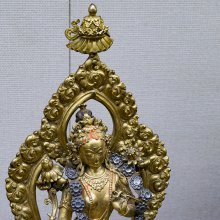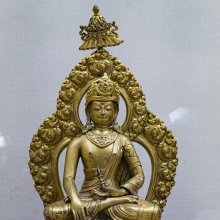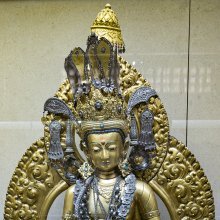Tuladhara, Tulādhāra, Tulādhara, Tula-dhara: 14 definitions
Introduction:
Tuladhara means something in Buddhism, Pali, Hinduism, Sanskrit, Marathi. If you want to know the exact meaning, history, etymology or English translation of this term then check out the descriptions on this page. Add your comment or reference to a book if you want to contribute to this summary article.
Images (photo gallery)
In Hinduism
Purana and Itihasa (epic history)
Source: archive.org: Puranic EncyclopediaTulādhāra (तुलाधार).—A charitable and righteous Vaiśya who lived in Kāśī. He gave the sage Jājali dharmopadeśa and both of them entered heaven. (See under Jājali).

The Purana (पुराण, purāṇas) refers to Sanskrit literature preserving ancient India’s vast cultural history, including historical legends, religious ceremonies, various arts and sciences. The eighteen mahapuranas total over 400,000 shlokas (metrical couplets) and date to at least several centuries BCE.
Jyotisha (astronomy and astrology)
Source: Wisdom Library: Brihat Samhita by VarahamihiraTulādhara (तुलाधर) or simply Tulā refers to the sign of Libra, according to the Bṛhatsaṃhitā (chapter 5), an encyclopedic Sanskrit work written by Varāhamihira mainly focusing on the science of ancient Indian astronomy astronomy (Jyotiṣa).—Accordingly, “If the sun and moon should begin to be eclipsed when only half risen, deceitful men will suffer as well as sacrificial rites. [...] If they should be eclipsed when in the sign of Libra (Tulā) [i.e., tulādhara], the people of the extreme border lands on the west, the people of Sindha, the trading classes and the people of Kaccha will be afflicted with miseries. If when in the sign of Scorpio (Vṛścika), the people of Udambara, of Madra, of Colā and of Yaudheya will all suffer miseries along with soldiers armed with poisoned weapons”.

Jyotisha (ज्योतिष, jyotiṣa or jyotish) refers to ‘astronomy’ or “Vedic astrology” and represents the fifth of the six Vedangas (additional sciences to be studied along with the Vedas). Jyotisha concerns itself with the study and prediction of the movements of celestial bodies, in order to calculate the auspicious time for rituals and ceremonies.
Yoga (school of philosophy)
Source: ORA: Amanaska (king of all yogas): A Critical Edition and Annotated Translation by Jason BirchTulādhāra (तुलाधार) refers to the “weigher”, according to the Amanaska Yoga treatise dealing with meditation, absorption, yogic powers and liberation.—Accordingly, as Īśvara says to Vāmadeva: “[...] Just as the weigher holds the unstable scales (tulādhāra) steady, so, the [unstable] activities of [the Yogin's] mind [are held steady] in the self, when [transcendental] happiness has arisen through his constant practice. [...]”.

Yoga is originally considered a branch of Hindu philosophy (astika), but both ancient and modern Yoga combine the physical, mental and spiritual. Yoga teaches various physical techniques also known as āsanas (postures), used for various purposes (eg., meditation, contemplation, relaxation).
In Buddhism
Theravada (major branch of Buddhism)
Source: Pali Kanon: Pali Proper NamesA mountain in the village of Viharavapi (Mhv.xxiii.90). It was in Rohana, and the vihara on it was the residence of Mahapaduma, the reciter of the Jatakas, from whom Ilanaga heard the Kapi Jataka (Mhv.xxxv.30).
There was also, probably, a village of the same name as the mountain, for it is mentioned (Cv.xlvi.12) as having been given by Aggabodhi IV. for the maintenance of the Padhanaghara built by him.
Theravāda is a major branch of Buddhism having the the Pali canon (tipitaka) as their canonical literature, which includes the vinaya-pitaka (monastic rules), the sutta-pitaka (Buddhist sermons) and the abhidhamma-pitaka (philosophy and psychology).
Languages of India and abroad
Marathi-English dictionary
Source: DDSA: The Molesworth Marathi and English Dictionarytulādhāra (तुलाधार).—m S The post of a fixed balance: also the beam.
--- OR ---
tuḷādhāra (तुळाधार).—ad Exactly, justly, fairly, with nice and rigid accuracy--deciding, speaking, behaving.
Source: DDSA: The Aryabhusan school dictionary, Marathi-Englishtulādhāra (तुलाधार).—m The beam.
--- OR ---
tuḷādhāra (तुळाधार).—ad Exactly, justly, fairly, with nice and rigid accuracy-deciding, speaking, behaving.
Marathi is an Indo-European language having over 70 million native speakers people in (predominantly) Maharashtra India. Marathi, like many other Indo-Aryan languages, evolved from early forms of Prakrit, which itself is a subset of Sanskrit, one of the most ancient languages of the world.
Sanskrit dictionary
Source: DDSA: The practical Sanskrit-English dictionaryTulādhara (तुलाधर).—
1) a trader, merchant.
2) the sign Libra of the zodiac.
3) The sun; तुला- धरस्तु वणिजि श्लक्ष्णराशौ दिवाकरे (tulā- dharastu vaṇiji ślakṣṇarāśau divākare) Nm.
Derivable forms: tulādharaḥ (तुलाधरः).
Tulādhara is a Sanskrit compound consisting of the terms tulā and dhara (धर).
--- OR ---
Tulādhāra (तुलाधार).—a dealer, trader, or merchant.
2) the string of a balance.
3) the beam.
4) the sign Libra of the zodiac.
Derivable forms: tulādhāraḥ (तुलाधारः).
Tulādhāra is a Sanskrit compound consisting of the terms tulā and dhāra (धार).
Source: Cologne Digital Sanskrit Dictionaries: Shabda-Sagara Sanskrit-English DictionaryTulādhara (तुलाधर).—m.
(-raḥ) The sun. E. tulā the sign, and dhara who has or possesses. tulāyā mānadaṇḍasya dharaḥ dhṛ-ac .
--- OR ---
Tulādhāra (तुलाधार).—mfn.
(-raḥ-rā-raṃ) A trader, a dealer, trafficking, trading. m.
(-raḥ) 1. The sign Libra. 2. The string of a balance. 3. The beam. E. tulā the scales, &c. ādhāra what or who supports.
Source: Cologne Digital Sanskrit Dictionaries: Monier-Williams Sanskrit-English Dictionary1) Tulādhara (तुलाधर):—[=tulā-dhara] [from tulā > tul] m. ‘scale-holder’ = la, [Varāha-mihira’s Bṛhajjātaka; Laghujātaka, by Varāha-mihira i.]
2) Tulādhāra (तुलाधार):—[=tulā-dhāra] [from tulā > tul] mfn. bearing a balance, [Yājñavalkya ii, 102/103]
3) [v.s. ...] m. = -pragraha, [cf. Lexicographers, esp. such as amarasiṃha, halāyudha, hemacandra, etc.]
4) [v.s. ...] the beam, [Horace H. Wilson]
5) [v.s. ...] a merchant, [cf. Lexicographers, esp. such as amarasiṃha, halāyudha, hemacandra, etc.]
6) [v.s. ...] the bearer of an ordeal balance, [Viṣṇu-smṛti, viṣṇu-sūtra, vaiṣṇava-dharma-śāstra x, 8 f.]
7) [v.s. ...] = la, [cf. Lexicographers, esp. such as amarasiṃha, halāyudha, hemacandra, etc.]
8) [v.s. ...] Name of a merchant, [Mahābhārata xii, 9277 ff.]
Source: Cologne Digital Sanskrit Dictionaries: Yates Sanskrit-English Dictionary1) Tulādhara (तुलाधर):—[tulā-dhara] (raḥ) 1. m. The sun.
2) Tulādhāra (तुलाधार):—[tulā+dhāra] (raḥ) 1. m. Libra; string or beam of a balance; a trader.
[Sanskrit to German]
Sanskrit, also spelled संस्कृतम् (saṃskṛtam), is an ancient language of India commonly seen as the grandmother of the Indo-European language family (even English!). Closely allied with Prakrit and Pali, Sanskrit is more exhaustive in both grammar and terms and has the most extensive collection of literature in the world, greatly surpassing its sister-languages Greek and Latin.
Kannada-English dictionary
Source: Alar: Kannada-English corpusTuḷādhara (ತುಳಾಧರ):—[noun] a man who holds a balance; a merchant.
Kannada is a Dravidian language (as opposed to the Indo-European language family) mainly spoken in the southwestern region of India.
Nepali dictionary
Source: unoes: Nepali-English DictionaryTulādhara (तुलाधर):—n. 1. a businessman; 2. a Newar surname;
Nepali is the primary language of the Nepalese people counting almost 20 million native speakers. The country of Nepal is situated in the Himalaya mountain range to the north of India.
See also (Relevant definitions)
Partial matches: Dhara, Tara, Na, Tula.
Starts with: Tuladharana, Tuladharapabbata.
Query error!
Full-text: Weigher, Taulin, Tuladharapabbata, Tuladhar, Jajali, Tula, Mahadhammarakkhita, Ilanaga, Matta, Varanasi, Mahakapi Jataka, Patta.
Relevant text
Search found 17 books and stories containing Tuladhara, Tula-dhara, Tulā-dhara, Tulā-dhāra, Tula-dhara-na, Tulā-dhara-ṇa, Tulādhāra, Tuḷādhāra, Tulādhara, Tuḷādhara; (plurals include: Tuladharas, dharas, dhāras, nas, ṇas, Tulādhāras, Tuḷādhāras, Tulādharas, Tuḷādharas). You can also click to the full overview containing English textual excerpts. Below are direct links for the most relevant articles:
Yavanajataka by Sphujidhvaja [Sanskrit/English] (by Michael D Neely)
Verse 2.26 < [Chapter 2 - One’s Own Form of the Horās]
Verse 4.15 < [Chapter 4 - The Rule of the Objects of the Zodiac Signs and Planets]
Verse 2.28 < [Chapter 2 - One’s Own Form of the Horās]
Animal Kingdom (Tiryak) in Epics (by Saranya P.S)
Notices of Sanskrit Manuscripts (by Rajendralala Mitra)
Mahabharata (English) (by Kisari Mohan Ganguli)
Section CCLXI < [Mokshadharma Parva]
Section CCLXIV < [Mokshadharma Parva]
Section CCLXIII < [Mokshadharma Parva]
Vinaya (2): The Mahavagga (by T. W. Rhys Davids)
Mahavagga, Khandaka 1, Chapter 48 < [Khandaka 1 - The Admission to the Order of Bhikkhus]
Mahabharata (English Summary) (by Kisari Mohan Ganguli)
Section CCLXI - Bhishma narrates conversation between Jajali and Tuladhara < [Mokshadharma Parva]
Section CCLXIII - Tuladhara's Wise Advice on Duties and Sacrifices < [Mokshadharma Parva]
Section CCLXIV - Tuladhara's Wisdom: Importance of Faith in Duty and Sacrifice < [Mokshadharma Parva]
Related products



